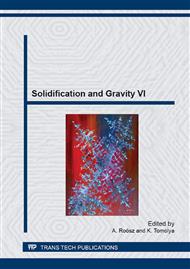[1]
H.W. Kerr, J. Cisse, Bolling G.F., On equilibrium and non-equilibrium peritectic transformations, On equilibrium and non-equilibrium peritectic transformations. Acta Metall. 22 (1974), 677-686.
DOI: 10.1016/0001-6160(74)90077-7
Google Scholar
[2]
H. Fredriksson, T. Nylen, Mechanism of peritectic reactions and transformations, Mechanism of peritectic reactions and transformations. Met. Sci., 16 (1982), 283-294.
DOI: 10.1179/030634582790427370
Google Scholar
[3]
E.P. Kalinushkin, E. Fras, W. Kapturkiewicz, A.A. Burbelko and J. Sitalo: Formation of Austenite in Peritectic Fe-C-X Alloy, Mat. Sci. Forum, 329-330 (2000), 185-190.
DOI: 10.4028/www.scientific.net/msf.329-330.185
Google Scholar
[4]
K. Matrsuura, H. Maruyama, Y. Itoh, M. Kudoh, K. Ishii, Rate of Peritectic Reaction in IronCarbon System Measured by Solid/Liquid Diffusion Couple Method, ISIJ Int., 35 (1995), 183.
DOI: 10.2355/isijinternational.35.183
Google Scholar
[5]
A. Das, I. Manna, S.K. Pabi, A numerical model of peritectic transformation. A numerical model of peritectic transformation, Acta Mater., 47 (1999), 1379-1388.
DOI: 10.1016/s1359-6454(98)00427-3
Google Scholar
[6]
I. Ohnaka, Mathematical-analysis of solute redistribution during solidification with diffusion in solid-phase, Trans. of the ISIJ, 26 (1986), 1045-1051.
DOI: 10.2355/isijinternational1966.26.1045
Google Scholar
[7]
C.Y. Wang, C. Beckermann, A unified solute diffusion model for columnar and equiaxed dendritic alloy solidification, Mat. Sci. Eng. A, 171 (1993), 199-211.
DOI: 10.1016/0921-5093(93)90407-6
Google Scholar
[8]
A. A. Howe, Micro-segregation: Issues of Growth Rate and the Peritectic, Mat. Sci. Forum, 649 (2010), 419-424.
DOI: 10.4028/www.scientific.net/msf.649.419
Google Scholar
[9]
C.Y. Wang and C. Beckermann, Prediction of columnar to equiaxed transition during diffusioncontrolled dendritic alloy solidification, Metall. Mater. Trans. A, 25A (1994), 1081-1093.
DOI: 10.1007/bf02652282
Google Scholar
[10]
D. Tourret, Ch. -A. Gandin, A generalized segregation model for concurrent dendritic, peritectic and eutectic solidification, Acta Materialia, 57 (2009), 2066-(2079).
DOI: 10.1016/j.actamat.2009.01.002
Google Scholar
[11]
H. Zhang, Ch. -A. Gandin, K. Nakajima, J. He, Mater. Sci. and Eng., 33 (2012), 012063.
Google Scholar
[12]
S. Chang, D. Shangguan, D. Stefanescu, Modeling of the liquid/solid and the eutectoid phase transformation in spheroidal graphite cast iron. Metal. Trans. A, 23A (1992), 1333-1346.
DOI: 10.1007/bf02665065
Google Scholar
[13]
T. Skaland, O. Grong, T. Grong, A model for the graphite formation in ductile cast iron. Metal. Trans. A, 24A (1993), 2347-2353.
DOI: 10.1007/bf02648606
Google Scholar
[14]
S.M. Yoo, A. Ludwig, P.R. Sahm, Numerical simulation of nodular cast iron in permanent moulds, in: J. Beech and H. Jones (Eds. ), Solidification Processing, Renmor House, Univ. of Sheffield, 1997, pp.494-497.
Google Scholar
[15]
M.I. Onsoien, O. Grong, O. Gundersen, T. Skaland, A process model for the micro-structure evolution in ductile cast iron: part I, Metall. Mat. Trans. A, 30A (1999), 1053-1068.
DOI: 10.1007/s11661-999-0158-x
Google Scholar
[16]
V. Mathier, A. Jacot, M. Rappaz, Coalescence of equiaxed grains during solidification. Modelling and Simulation in Materials Science and Engineering, 12 (2004) 479÷490.
DOI: 10.1088/0965-0393/12/3/009
Google Scholar
[17]
S. Vernède, M. Rappaz, Transition of the mushy zone from continuous liquid films to a coherent solid, Philos. Mag., 86 (2006), 3779-3794.
DOI: 10.1080/14786430500228705
Google Scholar
[18]
S. Vernède, M. Rappaz, A simple and efficient model for mesoscale solidification simulation of globular grain structures, Acta Mater., 55 (2007), 1703-1710.
DOI: 10.1016/j.actamat.2006.10.031
Google Scholar
[19]
A. Burbelko, J. Początek and M. Królikowski, Application of averaged Voronoi polyhedron in the modelling of crystallisation of eutectic nodular graphite cast iron. Arch. of Foundry Eng., 13 (2013), 134-140.
DOI: 10.2478/afe-2013-0026
Google Scholar
[20]
A. Burbelko, J. Początek: in The TMS 2013 Annual Meeting Supplemental Proceedings. TMS, John Wiley & Sons, Inc., 2013, 523-530.
DOI: 10.1002/9781118663547.ch65
Google Scholar
[21]
A.N. Kolmogorov, On the Statistical Theory of Metal Crystallisation, Bull. Acad. Sci. USSR, 3, (1937), 355 (in Russian).
Google Scholar
[22]
H.L. Lukas, S.G. Fries, B. Sundman, Computational Thermodynamics: The Calphad Method, Cambridge, University Press, (2007).
DOI: 10.1017/cbo9780511804137
Google Scholar
[23]
R. Agarwal, P. Samui, Enthalpy increment and heat capacity of Pb3Bi, J. of Alloys and Comp., 508 (2010), 333-337.
DOI: 10.1016/j.jallcom.2010.08.115
Google Scholar


